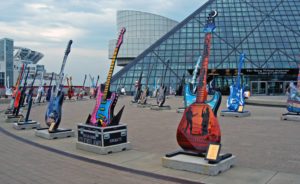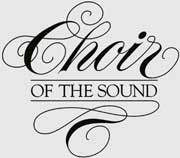
–By Linda
We often speak of the United States as a melting pot, where the traditions brought by our immigrant population mingle to form a new culture. That is certainly true of rock & roll, one of the musical forms that is most genuinely American, and the beginnings of which developed in this land even before the colonies formed into the nations we know today. Early in the process of European colonization, slaves were brought from Africa to supplement the labor of the indentured workers from Ireland, Scotland, and England. The Africans used complex, syncopated rhythms to drive their work songs; the British used topical ballads to spread news and commemorate tragedies or injustices. From these, combined with Methodist hymns, the American spiritual developed.
After the Civil War, when there was somewhat less need for veiled references and coded subtexts, spirituals continued to develop in different ways. The blues used familiar melodic patterns of call and response, and repeated lines, but early blues singers prided themselves on singing frankly about their suffering, their fears, and their loves and desires. Meanwhile, in churches, religious songs could be equally straight forward about God. No longer needing to put biblical references to use in planning for freedom, gospel music grew and thrived. More black musicians were able to find training in classical European music; among them was William Christopher (W.C.) Handy, who transcribed the Delta Blues he heard in rural Mississippi, and found a way to capture the “blue note” in standard musical notation. The publishing company he founded spread his own compositions, and helped turn a regional style into a national sensation. His contemporary Scott Joplin used syncopation in his piano compositions; rather than working in waltz-time for dances, or march-time for parades, he broke up his melodies and played them in “ragged-time,” or, as people began to say, ragtime.
A few years later, in New Orleans, Jelly Roll Morton and Louis Armstrong put the broken melodies of ragtime over the “walking bass” line frequently found in the blues, and created a highly danceable sound that caught on and spread rapidly. Count Basie, Duke Ellington, Fletcher Henderson, and others composed and arranged this type of music for the brass and rhythm instruments that comprised the swing band; white band leaders such as Artie Shaw, Tommy Dorsey, and Glenn Miller were soon giving the sound their own interpretations. Throughout the country and across social classes, big-band jazz was the soundtrack of the 1930s. While some artists were turning the blues into jazz, others were taking it in different directions. Instead of making it swing, they were making that backbeat jump. Muddy Waters, B.B. King, and Ray Charles wrote grittier music with a driving beat that reversed the roles of the swing band’s instruments, making the guitar and piano dominant and the horns backup, if they were used at all. They were joined by such vocalists as Dinah Washington, Sam Cooke, and Aretha Franklin, who had developed their voices while singing gospel music in their churches before bringing that soulful sound to earthier lyrics. By the end of the 1940s, Billboard had coined the term Rhythm and Blues to describe this style. The term “race records” no longer applied, since Elvis Presley, Jerry Lee Lewis, and other white performers were making music in the same style. All of these artists were recording, and ever-broader distribution made them available in Continental Europe and Great Britain. Mick Jagger, Jimmy Page, John Lennon, and Eric Clapton all found inspiration there; when they toured America with their own bands as part of the British Invasion, they knew they were bringing their music back to its home.
The streams of American music that led to rock, jazz, hip hop, and funk continue to merge and divide to produce new sounds and blended styles. Alt-rock, rockabilly, and alt-country draw more heavily on the Appalachian folk tradition; zydeco and western swing include Caribbean and Mexican influences, which in turn were shaped when African slaves were brought the West Indies and the Mexican mainland to blend their rhythms with the music of Spanish colonists. Old traditions are continually rediscovered and reshaped, finding ever more ways of playing with that same old back-beat rhythm. Long live rock & roll – and spirituals, and jazz – in whatever guise they appear.

